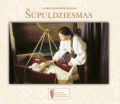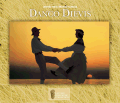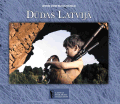



|
|
The Latvian Folk Music Collection
 ĐŰPUĎDZIESMAS (Lullabies) DANCO DIEVIS (Latvian Dances II) DŰDAS LATVIJA (Latvian Bagpipes) * Ilgi SEJU VEJU (Sow The Wind) All titles released 2000 UPE / Latvia (www.upe.parks.lv) Despite its smallness, the again-independent Baltic republic of Latvia is another reminder that no country, whatever its size, has simple history or music. The Latvian Folk Music Collection is a starting place for someone venturing into Latvia's repertoire or seeking to remember a homeland. Latvia's distinct geographic regions likely produce localized song traditions. But these albums give a flavor of the larger setting. Until the mid-1800s, serfdom was still practiced, so the agricultural calendar and lifecycle events (birth, marriage, death) permeate Latvian song collections. A stable linguistic history has preserved songs that are quite old, yet later influences by Roman Catholic and Lutheran religious practices inevitably affected folk and popular song. Independent after WWI, Latvia came under Soviet control following WWII, a time during which folk song was within the ambit of nationalistic ideology and political doctrine.
 Latvian folklorists have been unusually active and began publishing song collections, which included composed and arranged works, in the 18th and 19th centuries. By 1873 the first Latvian Song Festival took place, an event which inaugurated the role of festivals and broad participation by Latvia's now 2.5 million citizens in their own musical celebrations. Extensive collections of song and music transcriptions have resulted in thousands of items reaching Latvian archives and music repositories, providing ample material for Latvia's cultural education and revival. One of these collections, that of Jekabs Vitolins, contains almost 300 lullabies and was drawn upon for Supuldziesmas. Here you can sample (with line-by-line translations) of a genre that must stand as one of the most ancient and basic purposes of human song. Many are similar in tone, yet what may work for a child on one occasion may not on another, so these songs range from gentle to spirited. (My favorite? "Cuci guli mazo bernin.")
Latvian folklorists have been unusually active and began publishing song collections, which included composed and arranged works, in the 18th and 19th centuries. By 1873 the first Latvian Song Festival took place, an event which inaugurated the role of festivals and broad participation by Latvia's now 2.5 million citizens in their own musical celebrations. Extensive collections of song and music transcriptions have resulted in thousands of items reaching Latvian archives and music repositories, providing ample material for Latvia's cultural education and revival. One of these collections, that of Jekabs Vitolins, contains almost 300 lullabies and was drawn upon for Supuldziesmas. Here you can sample (with line-by-line translations) of a genre that must stand as one of the most ancient and basic purposes of human song. Many are similar in tone, yet what may work for a child on one occasion may not on another, so these songs range from gentle to spirited. (My favorite? "Cuci guli mazo bernin.")
 My own children are grown up (and grandchildren still a ways off), however, so it is the far more spirited Danco Dievis that riveted my attention. The lead cut "Perkonitis," by the Dancu Muzikas Grupa, sets the mood. That group—along with Dziga, Laimas muzykanti, and Dandari—showcases a youthful vitality that makes clear these folks like to dance. "Suseklis" and "Vezu Dancis" follow, each with its own degree of wild abandon. Slower, reel/waltz-like songs vary the pacing, and a variety of instrumentation is presented. A few cuts seem Germanic (e.g. Saimniekdeli), yet all are traditional, with influences that have accumulated over the centuries. A look at your map will help discern from where outside sources are likely to have come.
My own children are grown up (and grandchildren still a ways off), however, so it is the far more spirited Danco Dievis that riveted my attention. The lead cut "Perkonitis," by the Dancu Muzikas Grupa, sets the mood. That group—along with Dziga, Laimas muzykanti, and Dandari—showcases a youthful vitality that makes clear these folks like to dance. "Suseklis" and "Vezu Dancis" follow, each with its own degree of wild abandon. Slower, reel/waltz-like songs vary the pacing, and a variety of instrumentation is presented. A few cuts seem Germanic (e.g. Saimniekdeli), yet all are traditional, with influences that have accumulated over the centuries. A look at your map will help discern from where outside sources are likely to have come.
 The notes to Dudas Latvija include an engraving from 1550 which depicts the Latvian bagpipe and hints at how far back peasants from this region enjoyed the instrument's enchanting drone and the bacchanalia that frequently accompanied its playing. In time, playing the instrument was restricted, even prohibited, and by the 20th century, the practice had all but died out. The Latvian bagpipe, "dudas" among other names, had its bag made from sheep-, dog-, or catskin (also seal stomachs!).
The notes to Dudas Latvija include an engraving from 1550 which depicts the Latvian bagpipe and hints at how far back peasants from this region enjoyed the instrument's enchanting drone and the bacchanalia that frequently accompanied its playing. In time, playing the instrument was restricted, even prohibited, and by the 20th century, the practice had all but died out. The Latvian bagpipe, "dudas" among other names, had its bag made from sheep-, dog-, or catskin (also seal stomachs!).
 Finally, there is the contrast of Seju Veju (Tie the Wind or Sow the Wind), a recording of pure "postmodern folklore" by the group Ilgi. Steeped in tradition, these performers also are no strangers to rock; along with traditional Latvian instruments, you will hear percussion, guitars, accordions, electric bass and youthful sensibilities in touch with both the 15th and 21st centuries. The band has spent two decades exploring the ancient roots of their native Latvian culture, but there is little doubt their ears have been informed by modern European influences from rock to jazz.
Finally, there is the contrast of Seju Veju (Tie the Wind or Sow the Wind), a recording of pure "postmodern folklore" by the group Ilgi. Steeped in tradition, these performers also are no strangers to rock; along with traditional Latvian instruments, you will hear percussion, guitars, accordions, electric bass and youthful sensibilities in touch with both the 15th and 21st centuries. The band has spent two decades exploring the ancient roots of their native Latvian culture, but there is little doubt their ears have been informed by modern European influences from rock to jazz.
The Latvian Folk Music Collection is superb and demonstrates once again what phenomenal music resides in the regions of our globe. It is well conceived, well packaged, produced in Latvia and deserves attention. Most notes are in Latvian and the extent of the English commentary varies with each title. The Latvian Folk Music Collection is growing, and the UPE web site and MP3 samples offer additional music and even Latvian folk instruments. A delight. - Richard Dorsett
Audio: All songs ©2000 UPE, used by permission More music from Latvia and the Baltics These CDs are now available in the US from cdRoots.com
Comment on this music or the web site. |
© 2000 RootsWorld. No reproduction of any part of this page or its associated files is permitted without express written permission.